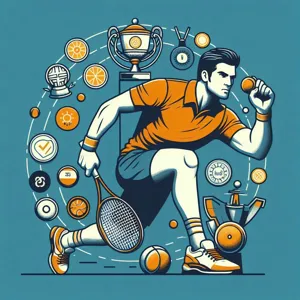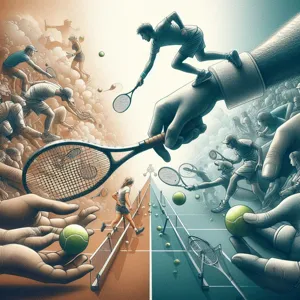Whether you’re a seasoned player or just starting to lace up your tennis shoes, the quest for improvement never truly ends.
Tennis is a game of skill, strategy, and mental toughness, and gaining a competitive edge can make all the difference on the court. In this blog post, we’ll delve into essential tips that will help you sharpen your game and elevate your performance to new heights. From perfecting your serve and mastering your footwork to honing your mental resilience and understanding your opponent’s tactics, these insights are designed to empower you with the tools you need to succeed. get ready to transform your approach to the game and leave your rivals in the dust as you step onto the court with renewed confidence and a sharper skill set!
1. Understanding Your Current Skill Level

Understanding your current skill level is the first and arguably the most crucial step in sharpening your game and gaining a competitive edge in tennis. Before you can aspire to improve, it’s essential to take a step back and assess where you stand. This self-evaluation isn’t just about knowing whether you can serve or volley; it involves a deeper analysis of your strengths, weaknesses, and playing style.
start by reflecting on your recent matches or practice sessions. Are you consistently losing points on your serve? Do you struggle with rallying from the baseline? Perhaps your net play is strong, but your footwork needs refinement. Consider keeping a journal to track your performance over time, noting specific areas where you excel and those that require attention.
Another effective method for gauging your skill level is to engage with a coach or experienced player who can provide an objective assessment. They can identify nuances in your technique and offer constructive feedback that you might overlook. Video analysis can also be a powerful tool; recording your matches allows you to visually assess your movements, strokes, and decision-making in real time.
Finally, don’t forget to evaluate your mental game. Tennis is as much a psychological battle as it is a physical one, and understanding your mental resilience, focus, and attitude during matches can significantly impact your performance. By taking the time to thoroughly assess your current skill level, you can set realistic goals for improvement, tailor your training regimen to your specific needs, and ultimately sharpen your game to gain that all-important competitive edge.
2. The Importance of Consistent Practice
Consistency in practice is the cornerstone of success in tennis, much like it is in any sport. Unlike the occasional hit on the court, consistent practice allows players to hone their skills, develop muscle memory, and build the endurance necessary to withstand the rigors of a match. Whether you’re a recreational player or aspiring to compete at higher levels, establishing a regular practice routine is vital.
When you commit to practicing consistently, you’re not just working on your serve or perfecting your backhand; you’re also cultivating a deeper understanding of the game. This means being able to read your opponent’s moves, anticipating shots, and responding effectively under pressure. Each session on the court reinforces technical skills while also enhancing your tactical awareness.
Consider breaking your practice into focused segments. For instance, dedicate time to drills that emphasize footwork, agility, and stroke techniques. Integrating match simulations into your routine can also be incredibly beneficial, as it helps you adapt your skills to real-game scenarios. Moreover, practicing regularly fosters a sense of rhythm and flow, which can be critical during high-stakes matches.
Additionally, the mental aspect of tennis cannot be overstated. Consistent practice not only strengthens your body but also sharpens your mind. It builds confidence, reduces anxiety, and prepares you for the inevitable ups and downs of competition. When you step onto the court, knowing you’ve committed to your training will allow you to focus on the game rather than worrying about your performance.
In summary, consistent practice is essential for players at all skill levels. It builds technical proficiency, enhances tactical understanding, and instills mental resilience. By prioritizing a steady practice routine, you’ll find yourself not only gaining a competitive edge but also enjoying the game more fully as you witness your own growth and improvement.
3. Mastering the Fundamental Techniques

Mastering the fundamental techniques is the cornerstone of elevating your tennis game to the next level. Whether you’re a beginner just stepping onto the court or a seasoned player looking to refine your skills, a strong foundation in the basics is essential for success.
Start with your grip. Understand the different types—such as the Eastern, Western, and Continental grips—and how they influence your strokes. A solid grip not only improves your control over the ball but also enhances your ability to generate spin and power. Spend time practicing each grip with various shots, ensuring that you can fluidly switch between them as the game demands.
Next, focus on your footwork. Tennis is a game of movement, and mastering your footwork will enable you to position yourself perfectly for each shot. Work on agility drills that emphasize lateral movement, quick changes of direction, and balance. The better your footwork, the more effectively you can anticipate your opponent’s shots and react accordingly.
Additionally, perfect your stroke mechanics. Pay attention to the intricacies of each shot—forehands, backhands, serves, and volleys. Break down each stroke into components, such as stance, swing path, and follow-through. Use drills and practice sessions to isolate and work on these components until they become second nature. Consider recording your practice sessions to analyze your technique and make necessary adjustments.
Lastly, don’t underestimate the importance of consistency. Drilling is crucial; practice hitting the same shot repeatedly until you can execute it flawlessly under pressure. Incorporate variety into your drills to simulate match situations, challenging yourself to maintain your technique while adapting to different scenarios.
By prioritizing and mastering these fundamental techniques, you’ll not only improve your overall game but also gain the confidence needed to take on tougher opponents. Your commitment to the basics will pay off, sharpening your skills and giving you the competitive edge you need to excel on the court.
4. Developing a Strong Mental Game
In tennis, physical prowess and technical skills are vital, but the true differentiator at higher levels of play often lies in the mental game. Developing a strong mental game is not just about remaining calm under pressure; it involves cultivating resilience, focus, and strategic thinking.
Firstly, mindfulness and visualization techniques can be game-changers. Spend a few minutes before each match envisioning your best performance—picture yourself executing flawless serves, returning powerful shots, and celebrating hard-fought points. This kind of mental rehearsal not only boosts your confidence but also prepares your mind to react positively in real-game situations.
Additionally, it’s essential to embrace a growth mindset. Each match, win or lose, presents a valuable learning opportunity. Analyze your performance objectively—identify what worked well and where you can improve. This practice not only helps you evolve as a player but also fosters an attitude that views challenges as stepping stones rather than roadblocks.
Another crucial aspect of mental toughness is handling pressure. High-stakes matches can be nerve-wracking, but training your mind to remain composed can significantly influence your performance. Techniques such as deep breathing exercises can help calm your nerves, allowing you to focus on the present moment rather than the outcome of the match.
Lastly, establish a routine that prepares you mentally before stepping onto the court. Whether it’s listening to a favorite song, engaging in a pre-match mantra, or performing specific warm-up drills, a consistent routine helps center your thoughts and promotes a sense of familiarity and control.
By prioritizing your mental game, you’ll not only enhance your performance but also cultivate a resilient mindset that can withstand the ups and downs of competitive play. Remember, in tennis, as in life, the right mindset can be your greatest ally on and off the court.
5. Effective Footwork and Positioning

In the high-stakes world of tennis, where split-second decisions can determine the outcome of a match, effective footwork and positioning are paramount to success. Your movement on the court is not just about speed; it’s about agility, balance, and the ability to anticipate your opponent’s next move. Mastering footwork allows you to position yourself optimally for each shot, ensuring you can respond quickly and efficiently.
Start by incorporating agility drills into your training regimen. Ladder drills, cone exercises, and shuttle runs can significantly enhance your foot speed and coordination. These exercises not only improve your quickness but also help you develop a more fluid movement pattern on the court. Remember, efficient footwork isn’t just about moving fast; it’s about moving smart. Work on your side-to-side movements and backward sprints to ensure you can reach every corner of the court.
Positioning, on the other hand, is about understanding the dynamics of the game. Always strive to return to the center of the court after each shot, as this puts you in the best possible spot to respond to your opponent’s next play. Learn to read your opponent’s body language and shot tendencies; this foresight will allow you to anticipate where the ball is likely to go, enabling you to position yourself effectively.
Additionally, pay attention to your stance and balance. A solid, athletic stance allows for quicker adjustments and a more powerful swing. Practice transitioning between different stances—open, closed, and neutral—to see how they affect your shot-making and movement.
Incorporating these elements of footwork and positioning into your practice sessions will not only enhance your performance but also give you that crucial competitive edge on the court. Remember, in tennis, the best players are often those who are not just quick, but who move with purpose and precision.
6. Strategies for Improving Your Serve
The serve is often considered the most crucial shot in tennis, serving as both the beginning of a point and a powerful weapon to gain an advantage over your opponent. To elevate your game and enhance your serving skills, consider incorporating the following strategies into your practice routine.
**1. Master Your Grip:** The grip you choose can dramatically influence the trajectory and spin of your serve. Experiment with different grips, such as the continental grip for a flat serve or the eastern grip for more topspin. Finding the right grip that feels comfortable and allows for maximum control will set the foundation for a powerful serve.
**2. Focus on Your Toss:** A consistent toss is vital for a successful serve. Aim to toss the ball slightly in front of you and at a height that allows for a full extension of your arm. Practice tossing the ball in a straight line and avoid any unnecessary movements that could throw off your rhythm. A well-placed toss can make all the difference in your serve accuracy.
**3. Develop Your Footwork:** Good footwork sets the stage for a strong serve. Position yourself properly behind the baseline, ensuring you have enough room to move into the shot. Practice lateral movements and quick steps to improve your positioning, allowing you to hit the ball at the optimal angle and with greater power.
**4. Utilize Different Types of Serves:** Variety is key to keeping your opponent guessing. Incorporate different types of serves into your game, such as flat, slice, and topspin serves. Each serve has its unique benefits; for example, a slice serve can pull your opponent wide off the court, while a topspin serve can push them back to the baseline.
**5. Analyze Your Mechanics:** Record your serves and review the footage to identify areas for improvement. Pay attention to your stance, swing path, and follow-through. Small adjustments in your mechanics can lead to significant enhancements in power and accuracy.
**6. Practice with Purpose:** Dedicated practice is essential for mastering your serve. Set aside specific practice sessions focused solely on serving. Use drills that target different aspects of your serve, such as speed, placement, and spin. Challenge yourself by aiming for specific targets in the service box or incorporating pressure situations to simulate match conditions.
**7. Seek Feedback:** Don’t hesitate to ask for feedback from coaches or more experienced players. They can provide valuable insights and tips that you may not have considered. Sometimes, an external perspective can reveal blind spots in your technique that are hindering your serve.
By focusing on these strategies, you can transform your serve into a formidable weapon on the court, giving you a competitive edge that can turn the tide of any match. Remember, improvement takes time and dedication, but the payoff is well worth the effort as you watch your confidence and performance soar.
7. Enhancing Your Groundstrokes

Enhancing your groundstrokes is a pivotal step in sharpening your tennis game and can significantly elevate your performance on the court. Groundstrokes are the foundation of your play, serving as your primary means of rallying, defending, and attacking. For beginners and seasoned players alike, mastering these shots can be the difference between a solid match and an outstanding one.
To start, focus on your grip. The right grip can dramatically affect your control and power. Experiment with the eastern or semi-western grip for forehands, as they allow for better topspin and versatility. For backhands, a two-handed grip often provides additional stability and precision, particularly for those still developing their strength.
Next, pay attention to your footwork. Proper footwork sets the stage for executing effective groundstrokes. Work on your agility and positioning by incorporating drills that require you to move quickly to different parts of the court. Remember, being in the right place at the right time is crucial; it allows you to hit the ball with your body aligned for optimal power and accuracy.
Practicing your swing mechanics is equally important. Focus on a smooth and controlled motion, employing a full follow-through to generate spin and depth. Consider incorporating drills that target specific aspects of your groundstrokes, such as hitting cross-court versus down-the-line shots, or varying your pace and angle to keep your opponent guessing.
Finally, consistency is key. Aim for a high percentage of successful hits during practice, gradually increasing the intensity and complexity of your drills. Consider partnering with a coach or a hitting partner who can provide feedback and simulate match conditions. By honing your groundstrokes, you’ll build confidence in your game, allowing you to dictate play and seize control during crucial moments on the court. With diligent practice and focus on these elements, you’ll find that your groundstrokes become one of your greatest assets, giving you the competitive edge you’ve been striving for.
8. The Role of Fitness and Conditioning
Fitness and conditioning play a pivotal role in elevating your tennis game to new heights. Unlike many sports, tennis demands not only skill and strategy but also an exceptional level of physical fitness. To outlast your opponent on the court, you need to be agile, strong, and enduring. This means investing time in a comprehensive fitness regimen that targets all aspects of your physical abilities.
Start with cardiovascular conditioning. Tennis matches can be lengthy, often requiring players to sprint, stop, and pivot on a dime. Incorporating exercises like running, cycling, or swimming into your routine will enhance your stamina and ensure that you can maintain a high level of performance throughout the match. High-intensity interval training (HIIT) is particularly effective, simulating the stop-and-go nature of tennis while improving your aerobic and anaerobic fitness.
Strength training is equally crucial, as it helps build the muscle necessary for powerful serves and groundstrokes. Focus on core strength, as a strong core is essential for balance and stability during play. Exercises like planks, medicine ball twists, and squats can significantly enhance your strength and overall performance on the court.
Flexibility and mobility are often overlooked but are vital for injury prevention and improved range of motion. Incorporate dynamic stretching before matches and static stretching afterward to keep your muscles limber. Yoga can also be a beneficial addition, helping you cultivate both flexibility and mental focus, allowing you to stay calm under pressure.
Lastly, don’t underestimate the importance of recovery. Adequate rest and nutrition are critical components of any fitness program. Ensure you’re giving your body the time it needs to heal and rebuild, and fuel it with a balanced diet to optimize your energy levels.
By prioritizing fitness and conditioning, you’ll not only enhance your physical capabilities but also build the mental resilience needed to withstand the rigors of competition. Embrace a holistic approach to your training, and watch as your performance on the court transforms, giving you the competitive edge you’ve been striving for.
9. Analyzing Your Opponent’s Game
Analyzing your opponent’s game is a crucial skill that can elevate your performance on the court. Tennis is not just about individual prowess but also about understanding your adversary’s strengths and weaknesses. Before stepping onto the court, take the time to observe your opponent’s playing style. Are they aggressive baseline players who thrive on powerful groundstrokes, or do they prefer to play at the net, capitalizing on volleys and put-aways?
Pay attention to their serve: Is it consistent, or do they struggle with double faults? How do they react under pressure—do they crumble or rise to the occasion? These observations can provide invaluable insights that allow you to tailor your strategy effectively.
Once the match begins, keep a close eye on their shot selection and movement. If they consistently hit to one side, it might indicate a weakness that you can exploit. Are they favoring their forehand over their backhand? Perhaps they struggle to return high balls or are vulnerable to drop shots.
Utilizing a mental or physical notebook during practice sessions can help you track these patterns. Jot down notes on your opponents’ previous matches or create a checklist of their tendencies. This preparation will not only enhance your gameplay but also boost your confidence, knowing you have a strategic plan in place.
In the heat of competition, being able to quickly adapt your game based on your opponent’s actions can make all the difference. Remember, tennis is as much a mental game as it is a physical one. By analyzing your opponent thoroughly, you can gain a competitive edge that sets you apart and leads you to victory.
10. Utilizing Technology for Performance Improvement
In today’s digital age, technology has revolutionized every aspect of sports, and tennis is no exception. Utilizing technology for performance improvement can be the game-changer you need to sharpen your skills and gain a competitive edge on the court. From sophisticated racquets equipped with sensors to advanced apps that track your performance, the tools at your disposal are more innovative than ever.
Imagine stepping onto the court with a racquet that can analyze your swing, providing real-time feedback on your stroke mechanics, spin, and power. These smart racquets use built-in sensors to capture data and transmit it to your smartphone, where you can dissect your performance post-match. This invaluable information allows you to identify patterns in your play, pinpoint areas for improvement, and adjust your training regimen accordingly.
Moreover, video analysis software has become a staple for serious athletes. By recording your matches or practice sessions, you can break down your technique frame by frame, gaining insights into your footwork, positioning, and shot selection. Many coaches utilize video analysis to provide athletes with a visual understanding of their performance, making it easier to communicate necessary adjustments.
Wearable technology, such as fitness trackers and heart rate monitors, can also play a crucial role in your training. By monitoring your physical exertion levels and recovery times, you can optimize your workout intensity and prevent injuries. Understanding how your body responds to different types of training can help you tailor your regimen for maximum performance.
Incorporating these technological advancements into your training routine not only helps to refine your skills but also keeps you motivated. The instant feedback and tangible metrics can inspire you to push through challenges and set achievable goals. As you embrace these tools, you’ll find that technology can significantly enhance your game, ensuring you step onto the court not just prepared, but also equipped with the insights needed to outplay your competition.
11. Setting Realistic Goals and Tracking Progress
Setting realistic goals and tracking progress are crucial components of any successful tennis training regimen. Whether you’re a budding amateur or an aspiring professional, having clear and achievable objectives provides direction and motivation on your journey to improvement. Start by breaking down your larger aspirations into smaller, manageable milestones. For instance, instead of simply aiming to win a tournament, focus on enhancing specific skills, such as improving your serve percentage or developing a more consistent backhand.
Once you have established your goals, it’s essential to track your progress diligently. Keeping a training journal can be incredibly beneficial; document your practice sessions, match outcomes, and any insights you gain along the way. This not only helps you stay accountable but also allows you to recognize patterns in your performance that might require further attention. Consider utilizing technology as well—apps and wearables can provide valuable data about your game, including shot accuracy, movement patterns, and even stamina levels.
Regularly reviewing your goals is vital to ensure they remain relevant and achievable. As you progress, you may find that your initial targets need to be adjusted to reflect your evolving skills and aspirations. Don’t hesitate to celebrate small victories; each step forward reinforces your commitment and passion for the game. Remember, tennis is as much a mental challenge as it is a physical one. By setting realistic goals and meticulously tracking your progress, you cultivate a growth mindset that fosters resilience and keeps you motivated, ultimately giving you the competitive edge you seek on the court.
12. Seeking Feedback from Coaches and Peers
In the world of tennis, self-reflection and improvement go hand in hand, and seeking feedback from coaches and peers is one of the most effective ways to sharpen your skills. Engaging with those who understand the sport deeply can provide you with insights that may not be evident from your own perspective. Whether you’re a seasoned player or just starting out, constructive criticism is invaluable for growth.
Coaches, with their wealth of experience, can pinpoint technical flaws in your stroke mechanics, serve, or footwork that you might not even be aware of. They can observe your gameplay from an objective standpoint, offering tailored drills and strategies to enhance your performance. Don’t hesitate to ask your coach specific questions about areas where you feel less confident or where you seek improvement. This dialogue fosters a collaborative environment that can propel your game to new heights.
Equally important is the input from your peers—players who are at a similar skill level or slightly above can offer relatable insights. They might notice patterns in your play that you overlook or share their own experiences with certain techniques and strategies. Engaging in practice matches or friendly rallies can be a fantastic opportunity to solicit feedback in a low-pressure setting. Ask them to watch your form, gauge your shot selection, or even your mental approach during matches.
Creating a feedback-friendly culture among your tennis community—whether it’s through informal discussions, practice sessions, or group training—can enhance everyone’s skills and foster a sense of camaraderie. Remember, every champion has a team supporting them, and leveraging the knowledge of those around you can be the key to unlocking your full potential on the court. So embrace the power of feedback, and watch your game transform as you absorb the insights and experiences of those dedicated to the sport.
13. The Power of Visualization and Positive Thinking
Visualization and positive thinking are powerful tools that can transform your performance on the tennis court. Imagine standing at the baseline, the sun shining down, and the sound of the ball being struck cleanly by your racket. Visualization techniques allow you to create these vivid mental images, helping you to prepare not just physically but mentally for your matches. By regularly picturing yourself executing perfect serves, powerful forehands, and agile footwork, you’re training your brain to recognize success as a tangible and achievable outcome.
Incorporating positive thinking into your routine further enhances this mental preparation. Instead of dwelling on past mistakes or anticipating failures, focus on affirmations that bolster your confidence. Phrases like “I am a strong player” or “I can adapt and overcome any challenge” reinforce a winning mindset. This shift in attitude can reduce anxiety and help you stay calm during crucial points in a match.
Moreover, many professional athletes swear by these techniques. Before stepping onto the court, they engage in visualization exercises, mentally rehearsing their strategies and visualizing victory. This mental practice not only fosters self-assurance but also sharpens focus and concentration when it matters most.
To harness the power of visualization and positive thinking in your own training, dedicate time each day to close your eyes and picture your ideal match scenario. Feel the emotions of success, experience the thrill of winning, and let that energy propel you forward. By embracing these mental strategies, you’ll not only enhance your performance but also cultivate a resilient mindset that can carry you through the ups and downs of competitive tennis. As you sharpen your game, remember that the mental aspect of sport is just as crucial as the physical – and with visualization and positivity in your arsenal, you’re already a step ahead of the competition.
14. Overcoming Common Mental Barriers
Tennis is as much a mental game as it is a physical one. While mastering your serves and perfecting your backhand are undoubtedly important, overcoming common mental barriers can often be the key to unlocking your full potential on the court. Many players find themselves grappling with anxiety, self-doubt, or the fear of failure—factors that can significantly hinder performance during crucial moments.
One of the most prevalent mental barriers is the fear of making mistakes. This fear can lead to a conservative playing style, where you hold back instead of taking risks that could lead to victory. To combat this, focus on embracing a growth mindset. Recognize that mistakes are a natural part of the learning process; each error is an opportunity to improve. Visualize yourself making bold plays and successfully executing challenging shots, allowing positive imagery to replace negative thoughts.
Another common hurdle is performance anxiety, especially when facing a formidable opponent or during important matches. To manage this anxiety, develop a pre-match routine that helps you relax and center your thoughts. Techniques such as deep breathing, visualization, and simple stretches can help to alleviate tension and put you in the right frame of mind. Remember, the goal is to channel your nervous energy into focus and determination rather than letting it overwhelm you.
Self-doubt can also creep in, particularly after a series of losses or poor performances. Combat this by setting realistic, achievable goals for each match. Instead of fixating on winning, concentrate on executing your game plan and improving specific aspects of your play. This shift in focus can help you build confidence and develop a sense of accomplishment, regardless of the match outcome.
Lastly, consider the power of positive self-talk. Replace negative thoughts with affirmations that reinforce your skills and abilities. Phrases like “I am prepared” or “I play my best when I stay calm” can serve as reminders of your strength and readiness. By cultivating a positive inner dialogue, you can foster resilience and maintain your composure under pressure.
In tennis, overcoming these mental barriers is not just about enhancing your performance; it’s about developing a robust mindset that can carry you through challenges both on and off the court. By recognizing and addressing these mental obstacles, you’ll not only sharpen your game but also gain a significant competitive edge that will set you apart from your opponents.
15. Staying Motivated and Passionate About the Game
Tennis, like any sport, demands not only skill and strategy but also an unwavering sense of motivation and passion. Staying motivated can sometimes feel like climbing an uphill battle, especially when facing setbacks such as injuries, losses, or plateaus in performance. The key is to find ways to reignite that initial spark that brought you to the court in the first place.
Start by reminding yourself why you fell in love with the game. Was it the thrill of a perfectly executed serve, the camaraderie with fellow players, or the exhilarating feeling of victory? Revisit those moments—watch videos of your favorite matches, relive your personal best performances, or simply spend time playing for the sheer joy of it. Engaging in these nostalgic experiences can reignite your passion and remind you of the beauty of tennis.
Setting new goals can also help maintain motivation. Whether it’s improving your serve, participating in local tournaments, or simply striving for a new personal record, having clear targets can provide a sense of purpose and direction. Celebrate small victories along the way, as these milestones can serve as powerful reminders of your progress and commitment to the sport.
Additionally, surrounding yourself with like-minded individuals who share your enthusiasm can be incredibly beneficial. Join a local club, participate in group lessons, or find a training partner who challenges and inspires you. The support and camaraderie of fellow players can create an encouraging environment that keeps you engaged and motivated.
Finally, remember to incorporate variety into your training regimen. Experiment with different drills, play on various surfaces, or even try your hand at related sports like pickleball or badminton. This fresh approach can break the monotony of routine practice and reignite your love for the game.
In the end, staying motivated and passionate about tennis is about nurturing that initial excitement and embracing the journey, with all its ups and downs. By fostering a mindset that views challenges as opportunities for growth and remembering the joy that brought you to the court, you can maintain your competitive edge and continue to thrive in the sport you love.
As we conclude our exploration of essential tips to gain a competitive edge in tennis, it’s clear that sharpening your game involves a combination of technique, strategy, and mental fortitude. By incorporating the insights shared in this post—ranging from mastering your footwork to refining your serve—you can elevate your performance on the court and outplay your opponents. Remember, every champion was once a beginner; it’s your dedication to practice and improvement that will set you apart. So grab your racquet, hit the courts, and embrace the journey of becoming the best version of yourself as a player. We can’t wait to hear about your victories and how these tips have impacted your game!






